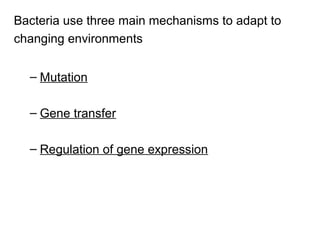
How Bacteria Adapt to Changing Environments Through Mutation, Gene Transfer and Regulation
- 1. Bacteria use three main mechanisms to adapt to changing environments – Mutation – Gene transfer – Regulation of gene expression
- 2. Mutation Spontaneous mutations occur infrequently and randomly in the natural environment Rate of spontaneous mutation Probability that a mutation will be observed in a given gene each time the cell divides Rate is generally between 1 in 10,000 and 1 in a trillion
- 5. Mutations are stable heritable changes in the base sequence of DNA Mutations can be caused by: Base substitutions Removal or addition of nucleotides Transposable elements
- 6. Base substitutions Most common type of mutation Results from mistakes during DNA replication Point mutations: when one base pair is changed Missense mutation Nonsense mutation: Mutation that changes an amino acid codon to a stop codon
- 8. Removal and addition of nucleotides Shifts the translational reading frame Called frameshift mutation because it affects all amino acids downstream from addition or deletion (frequently result in premature stops)
- 9. Transposable elements Special segments (transposons) of DNA that move spontaneously from one gene to a different gene Transposons may disrupt the integrity of the gene and render its protein product nonfunctional Read about Barbara McClintock (A Glimpse of History) on pg. 191
- 10. Mutations are essential for understanding genetics Mutations can be intentionally produced (induced mutations) to demonstrate function of particular gene or set of genes Mutations can be induced via: Chemical mutagens Transposition Radiation
- 11. Chemical mutagens Nitrous acid Changes cytosine to uracil Alkylating agents Alter hydrogen bonding of bases Nitrosoguanine is common alkylating agent Used as antineoplastic drugs Base analogs Chemicals that are structurally similar to the nitrogenous bases but have slightly altered base pairing properties Base analogs include: 2-aminopurine which incorporates in the place of adenine but binds with cytosine 5-bromouracil which incorporates in the place of thymine but binds with guanine
- 12. Intercalating agents Molecules that insert themselves between adjacent bases and create space between bases Ethidium bromide is common intercalating agent Potential carcinogen Used extensively in biochemical/molecular biological research
- 13. Transposition Common procedure used to induce mutation in the laboratory A transposon inserts into a gene (insertion mutation)
- 14. Radiation Ultraviolet light Causes covalent bonding between adjacent thymine bases forming thymine dimers which distort DNA X rays Cause breaks and alterations in DNA. Breaks that occur on both strands are often lethal
- 15. Mutations and Their Consequences Mutations provide the organism with a way to respond to environmental stresses Environment selects for cells suited to survive Environment does not cause mutation
- 16. WESTERN BLOT
- 17. WESTERN BLOT
- 18. WESTERN BLOT
- 21. WESTERN BLOT
- 22. NORTHERN BLOT
- 23. NORTHERN BLOT
- 24. NORTHERN BLOT
- 25. NORTHERN BLOT
- 26. SOUTHERN BLOT
- 27. Southern blot
- 29. Mechanisms of Gene Transfer Genes are naturally transferred between bacteria DNA-mediated transformation Transduction Conjugation
- 30. Gene exchange in bacteria 1. Donor DNA is transferred and accepted by the recipient cell Three mechanisms DNA-mediated transformation Transduction Conjugation 2. Donor DNA is integrated into the recipient cell’s chromosome
- 32. DNA-mediated transformation (transformation) The transfer of naked DNA from one bacterium to another Discovered by Fredrick Griffith in 1928 while working with Streptococcus pneumoniae Griffith realized S. pneumoniae existed in two forms Encapsulated, virulent form (smooth in appearance) Nonencapsulated, avirulent form (Rough in appearance) Griffith hypothesized that injections with the smooth strain could protect mice from pneumonia Griffith injected mice with the two different strains
- 34. Natural transformation occurs when bacterial cells are “competent” Competence is a condition in which bacterial cells are capable of taking up and integrating large fragments of DNA into their chromosome Competence usually occurs naturally during the late log, early stationary phase
- 35. Dying cells rupture during the stationary and death phases. The chromosome breaks into small pieces and explodes through the ruptured cell wall Recipient cells absorb pieces of “naked” DNA The naked DNA is integrated into the recipient cell’s chromosome Naked DNA integrates at a homologous site on the recipient’s chromosome
- 36. Entry of the DNA Only single strands enter Integration of the donor DNA Donor DNA is integrated at a homologous site Enzymes cleave recipient DNA Donor DNA replaces recipient DNA via recombination Cell multiplication Transformed cells multiply under selective conditions in which non transformed cells will not grow
- 37. Transduction Bacterial DNA that is transferred from donor to recipient via a bacterial virus (bacteriophage) Two types of transduction Generalized Any gene from the donor can be transferred Specialized Only specific genes can be transferred
- 38. Transduction
- 39. Conjugation Conjugation is mediated by a plasmid R plasmids F plasmids Conjugation requires direct contact between cells Cells must be of opposite mating types Donor cells carry a plasmid that codes for fertility factor or “F factor” This cell is designated F+ Recipient cell does not carry a plasmid This cell is designated F-
- 42. Conjugation
- 43. High frequency of recombination – Hfr strains
